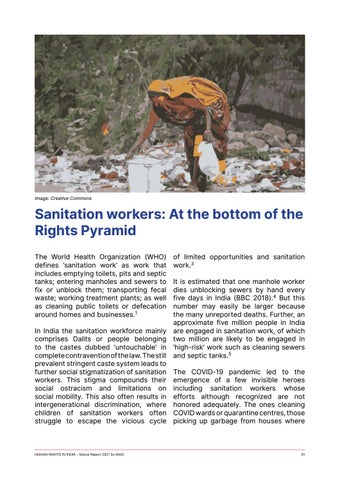Image: Creative Commons
Sanitation workers: At the bottom of the Rights Pyramid The World Health Organization (WHO) defines ‘sanitation work’ as work that includes emptying toilets, pits and septic tanks; entering manholes and sewers to fix or unblock them; transporting fecal waste; working treatment plants; as well as cleaning public toilets or defecation around homes and businesses.1
of limited opportunities and sanitation work.3
It is estimated that one manhole worker dies unblocking sewers by hand every five days in India (BBC 2018).4 But this number may easily be larger because the many unreported deaths. Further, an approximate five million people in India In India the sanitation workforce mainly are engaged in sanitation work, of which comprises Dalits or people belonging two million are likely to be engaged in to the castes dubbed ‘untouchable’ in ‘high-risk’ work such as cleaning sewers complete contravention of the law. The still and septic tanks.5 prevalent stringent caste system leads to further social stigmatization of sanitation The COVID-19 pandemic led to the workers. This stigma compounds their emergence of a few invisible heroes social ostracism and limitations on including sanitation workers whose social mobility. This also often results in efforts although recognized are not intergenerational discrimination, where honored adequately. The ones cleaning children of sanitation workers often COVID wards or quarantine centres, those struggle to escape the vicious cycle picking up garbage from houses where
HUMAN RIGHTS IN INDIA - Status Report 2021 by IAMC
91
